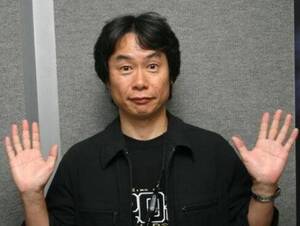
The two Japanese veterans were quizzed about various aspects of the Wii development cycle, here's a selection of answers that are of significant interest.
"Miyamoto: We started work on the Wii around the time the GameCube went on sale in 2001. [Internally, the Wii had the codename "Revolution."] We started with the idea that we wanted to come up with a unique game interface. Ultimately, it came down to whether power should be a key element of the console or not. We didn't think it was possible to build a powerful machine for less than 50,000 yen ($450). Not only would it use a lot of electricity, it would need a fan, which meant it would be noisy. Moms would rise up against it. Plus, it would take too long to boot up, like a PC, which isn't an ideal toy."
Looks like Miyamoto got exactly what he wanted, we all know the Wii isn't going to compare to the other consoles in terms of power, but it certainly has the new games interface that Shiggys was looking for.
"Miyamoto: Originally, I wanted a machine that would cost $100. My idea was to spend nothing on the console technology so all the money could be spent on improving the interface and software. If we hadn't used NAND flash memory [to store data such as games and photos] and other pricey parts, we might have succeeded."
Now we would be talking if Wii was only $100, I guess that wasn't quite possible, we do however want some new technology over the Gamecube, I think Nintendo can be pretty happy with their price when compared to other machines.
Miyamoto went on to explain the idea behind the graphics in Wii, and HDTV.
Miyamoto: We had to compromise on graphics and give up on a powerful chip. Many of our employees initially wanted high-definition graphics. But they agreed with us that graphics wouldn't matter if the games weren't fun to play. That said, the Wii is much faster than the GameCube. As new chip technology becomes available, we'll consider less power-hungry varieties that don't cost too much. And once high-definition TVs take off, we'll consider the merits of better graphics and more power."
We also discover that the DS did infact show the way in terms of design and interface for the Wii console.
"Miyamoto: The DS prepared the way for the Wii. The DS's unique interface had traction with nongamers. That made us think we had a shot at reaching a broader audience. But if the DS had flopped, we might have taken the Wii back to the drawing board."
You can read the rest of the interview over at BusinessWeek.
[source businessweek.com]


Comments 4
I don't think the Wii would have been taken seriously if it was $100 or £70. I'm glad they made a better machine even though its more expensive.
Yeah, you've got a point... it needs to be a decent price for people to take the technology seriously
$100 would have been so cheap that even I would have doubted the quality.
I wouldn't have minded paying £100 for a Wii and Zelda... but as you say, consumers are a cynical (read ignorant) lot and would probably see it as too cheap against the 360 or PS3. On another subject, got a free paper today (Metro in London) and almost every advert slot was a 360 advert... Come on nintendo! Get some ads out there! Althought adverts have started appearing on certain UK channels.. the ad just says 'What is Wii?' and shows the controller...
Tap here to load 4 comments
Leave A Comment
Hold on there, you need to login to post a comment...